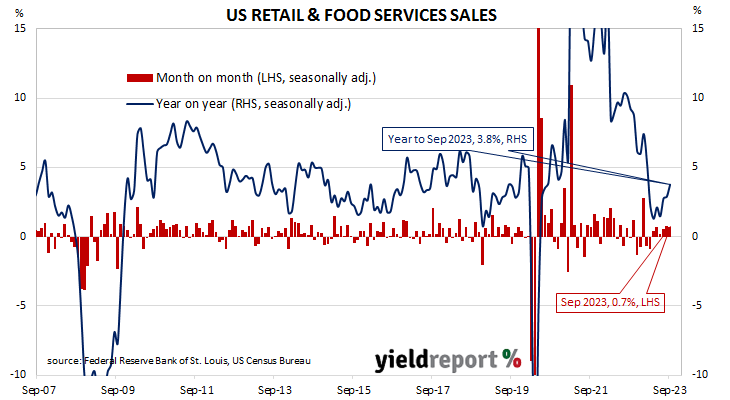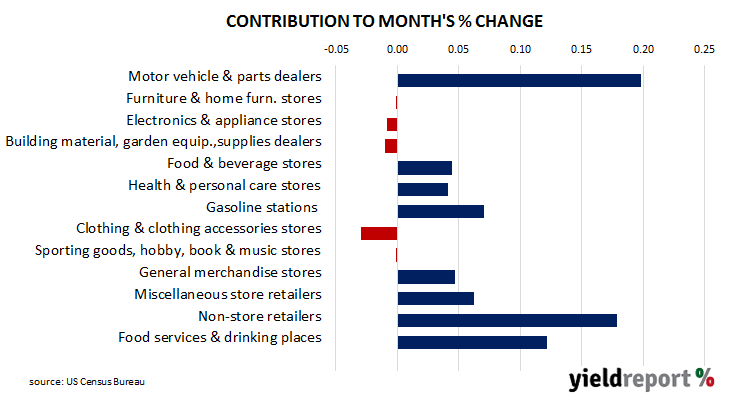Summary: US retail sales up 0.6% in September, considerably more than expected; annual growth rate accelerates to 3.9%; NAB: activity in the US remains strong; US Treasury yields jump; rate-cut expectations soften considerably; ANZ: strong momentum in consumption heading into Q4; higher sales in eight of thirteen categories; non-store retailer sales largest single influence on month’s result.
US retail sales had been trending up since late 2015 but, commencing in late 2018, a series of weak or negative monthly results led to a drop-off in the annual growth rate below 2.0%. Growth rates then increased in trend terms through 2019 and into early 2020 until pandemic restrictions sent it into negative territory. A “v-shaped” recovery then took place which was followed by some short-term spikes as federal stimulus payments hit US households in the first and second quarters of 2021.
According to the latest “advance” numbers released by the US Census Bureau, total retail sales increased by 0.7% in September. The result was considerably greater than the 0.3% increase which had been generally expected but it was slightly less than August’s 0.8% rise after it was revised up from 0.6%. On an annual basis, the growth rate accelerated from August’s revised rate of 2.9% to 3.8%.
“Headline retail sales were 0.7% versus 0.3% expected and the core control measure which feeds into GDP was 0.6% versus. 0.1% expected,” said NAB Head of Market Economics Tapas Strickland. “It is clear activity in the US remains strong.”
The figures were released at the same time as the latest US industrial production report and US Treasury yields increased significantly on the day. By the close of business, the 2-year Treasury yield had gained 11bps to 5.21%, the 10-year yield had jumped 14bps to 4.84% while the 30-year yield finished 8bps higher at 4.93%.
In terms of US Fed policy, expectations of a lower federal funds rate in the next 12 months softened considerably. At the close of business, contracts implied the effective federal funds rate would average 5.355% in November, 3bps more than the current spot rate, 5.41% in December and 5.445% in January. September 2024 contracts implied 5.085%, 24bps less than the current rate.
“The data indicate strong momentum in consumption heading into Q4, but the data are nominal, not real, so the volume performance will not be as strong,” said ANZ senior economist ANZ Adelaide Timbrell.
Eight of the thirteen categories recorded higher sales over the month. The “Non-store retailers” segment provided the largest single influence on the overall result, rising by 1.1% over the month and contributing 0.18 percentage points to the total.
The non-store segment includes vending machine sales, door-to-door sales and mail-order sales but nowadays this segment has become dominated by online sales. It now accounts for nearly 17% of all US retail sales and it is the second-largest segment after vehicles and parts.



